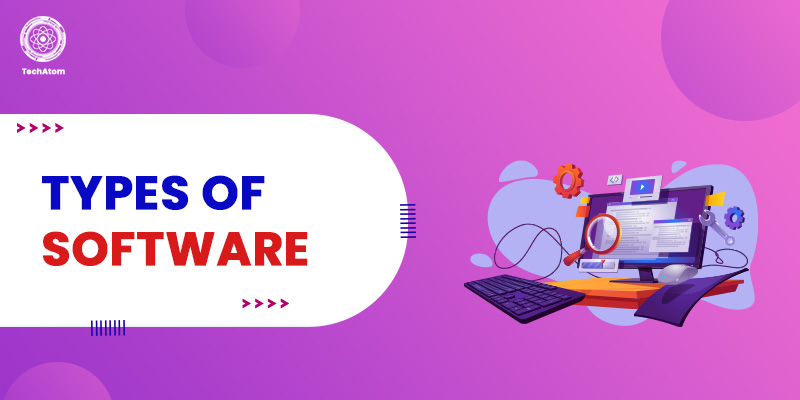Software is a word you hear and use almost every day. Whether you use a mobile phone, an ATM, a laptop, a computer, or a TV, the software is the heart of all these devices. It is a set of instructions, computer programs, and operating information the computer system uses to perform specific actions. In simple terms, it is a computer code that makes hardware operable.
This modern age heavily relies on mobile phones and software applications, as they have made human lives more convenient and comfortable. They have become a part of daily life.
Whether shopping online or transferring money to distant friends or family members, you use various applications daily to accomplish different tasks. While you do so, you are unaware of what type of software you use.
In this guide, you will learn what software is, how it works, and some different types of software available out there.
What is Software?
It is a backend program that dictates how a device will work. It is a collection of procedures, instructions, data, programs, and policies that tell a machine how to perform different tasks. What the software executes is displayed on the hardware devices as a result.
Generally, software is a generic term for applications, programs, or scripts that can execute on a computer system. It is entirely opposite to hardware, a physical system consisting of different components that perform tasks as the software directs.
How Does it Work?
The software requires input, which it processes to display the output. Pressing the power button on your laptop is an input for the software that boots the laptop up and wakes up the system. When you play music on your mobile, hitting a song is an input; the output is the melody in your ears.
It all works with the help of a program that contains instructions. These instructions work based on your input. For a computer or phone, these instructions are written in machine language. Only it can understand the jargon. Based on your input and the instructions, the software then creates an output, sometimes in the form of a printout or by playing a movie. Your hardware and software work together to smoothen the entire process for you.
So, all software work on the principle of input → process → output.
10 Different Types of Software You Should Be Aware of
As discussed earlier, the term software is generic for any computer program, script, or application. You use a variety of software on your desktop or mobile phone. For instance, you use Instagram or WhatsApp every day. The heart of your computer system, an operating system, is also a software program that controls both the hardware and software resources. Have you ever wondered what kind of software they are?
There are various types of software available. But to employ them for better use, you must know about them.
Here are different types of software that you must know about:
1. System Software
It is a type of software that manages a computer. It helps the computer start, manage tasks, and execute inherent orders. When you turn on your system, the system software starts working. It helps the computer wake up and prepare the platform for other software programs and applications.
An operating system is a type of software that users do not use directly. Everything that works in the background and makes your computer work seamlessly comes under the definition of system software.
All operating systems, such as Microsoft Windows, iOS, Android, and Linux, are system software. Other examples of system software other than operating systems include game engines, computational science software, Software-as-a-Service (SaaS) applications, and industrial automation software.
Most people think that if they cannot use this type of software directly, what is its significance? But it defines the way your system works. You can understand it by recalling why you chose the iPhone instead of Samsung.
2. Application Software
They are designed by keeping in mind the users of that application. Also, they are commonly known as "apps". Apps are designed for different purposes and perform the intended functions. In short, an application is software that performs a particular task, such as streaming video, playing music, creating documents, spreadsheets, playing games, etc.
This type of software addresses the user's problems, such as a cab booking application arranging for a taxi at your door, a chess application helping you learn a game, a fitness application helping you keep fit, etc. As mobile phone usage increases, the number of applications and their usage increases simultaneously.
The following are examples of application software that will provide a clear picture of what application software are:
- Database Software: With the help of this type of software, you can collect and store data from different sources. Some examples of database software are MySQL, FoxPro, Oracle Database, FileMaker Pro, etc.
- Word Processing Software: With the help of word processing software, you can create, edit, format, and output text. Some common examples are Microsoft Word, AppleWorks, Notepad, Wordpad, etc.
- Communication Applications: You can communicate with multiple users via audio and video streaming using communication applications. Some examples of communication software are Zoom, Skype, Google Meet, etc.
- Enterprise Software: They supervise the entire working of an enterprise, including procurement, human resource, marketing, warehousing, customers, relationship management, etc. Some examples are ERP software, Business Intelligence tools, CRM, project management tools, etc.
- Presentation Software: This type of software helps you create appealing presentations using ready-to-use templates. Microsoft Powerpoint, Google Slides, keynotes, and Prezzy are popular presentation software.
- Email Software: These software applications help you send and receive emails to people and organizations across the globe. Microsoft Outlook, Gmail, and Apple Mail are popular examples of email software.
Any software solution you require to fulfill your business needs falls under the category of application software.
3. Driver Software
Have you ever wondered why your computer listens to the keyboard's commands or dances to the mouse's tunes? It’s because the hardware communicates internally with the software. A driver is software that links computer hardware to an external device, such as a keyboard, mouse, printer, USB drive, etc. It tells the computer what kind of device has been attached, how it works, and how it can communicate.
Driver software is a type of system software. The manufacturer who manufactures the peripheral device creates the driver software. The developers create the code that makes the device work properly.
Every hardware device you use on your computer system, such as a graphics card, network card, keyboard, or printer, requires a driver to be functional. When you insert a USB drive into your computer, the OS recognizes it. After that, the driver is installed to make the USB drive functional.
4. Programming Software
Have you ever considered how the software applications you use daily are developed? The simple answer to this question is programming software. This type of software is of no use to you unless you are a programmer or a developer. It is a collection of tools developers and programmers use to create new software.
In general, programming software is called "programming tools," as they enable a programmer to create, debug, and interpret software. A suite of programming tools includes compilers, assemblers, debuggers, interpreters, etc.
Today, programmers use an Integrated Development Environment (IDE), which makes debugging, rewriting, and rectifying much easier.
You will find a plethora of programming software on the internet. Some common examples of programming software are Notepad++, Eclipse, GitLab, Atom, Sublime Text, etc.
5. Firmware
Firmware is software installed on a device’s motherboard or chipset to ensure that the device functions correctly. It is an instruction set that is stored on a flash ROM. These instructions can be updated when you change the operating system. Thus, semi-permanent software stays and works on a device unless and until it is updated.
An example of firmware is the basic input-output system (BIOS) on personal computers.
6. Open Source Software
The term is self-explanatory. Open-source software is one whose source code is available for modification by anyone who knows how to make changes to improve it. Simply put, it is a type of software with publicly available source code. End users don’t see it often. But it's the part of the software that defines how the software will work.
The reason behind making software open-source is the rapid exchange, massive participation, and goal-driven development.
If a person is using open-source software and possesses some programming knowledge, they can use that knowledge to add additional features by writing code. However, open-source software licenses limit how a code can be modified.
The most common examples of open-source software are Linux OS, WordPress CMS, repositories, etc.
7. Utility Software
As the name suggests, this software works in the background with system software to ensure that the computer, phone, or other device runs smoothly. They perform various functions, such as data backups, antivirus detection, sending alerts, file management, etc.
If a problem hinders a system's performance, they alert you to take action or ask for permission to take the required action. In short, this type of software helps you ensure that things on a computer system are stable. It makes sure that your system does not get damaged due to overuse.
Examples of utility software include antivirus programs, backup utilities, Windows Task Manager, etc.
8. Freeware
Freeware software is available to the public at large without any cost. It makes people wonder if it is the same as open-source software. The answer is no. In open-source software, the developers have access to the source code. Freeware does not offer you this luxury. It is owned by the developer and distributed free of cost.
There are restrictions regarding the use and sharing of freeware. So, use them after reading the licensing requirements. The best thing about freeware is that you can install, use, and uninstall it after accomplishing the task. There is no need to upgrade or take a membership.
There are thousands of free programs that you must be using even now. Some are Adobe PDF Reader, Google Talk, audio applications, etc.
9. Shareware
Shareware is software that is available for free but only for a limited period. You can install it, use it, see if you like it, and if you do, pay for it for continued usage. This type of software allows you to experience it before you purchase a license. There can be instances where you pay beforehand and later find that the application is not what you imagined. Using shareware saves you from disappointment later.
While some shareware software provides a limited set of features, some offer all features for a short period. Using software before you purchase it is the best way to avoid expenses and evaluate it to verify whether it fits your requirements.
Adobe Photoshop, Winzip, etc., are some examples of shareware software.
10. Closed-Source Software
This type of software is in contrast to open-source software. It does not make its source code public, and the licenses are strict. Any individual cannot copy or crack the source code without authorization.
Closed-source software requires you to pay a specific amount of money to be used. Generally, they are designed for commercial purposes. As companies hire developers to write code for their applications, they prefer not to expose the source code.
The best example of closed-source software is Skype, a video conferencing software. Though it is free to use, it charges certain fees for high-volume users.
Final Thoughts
To conclude, the software is simply a set of instructions provided to a computer system to perform a specific action or task. System software and application software are the two major types of software, while others are some popular classifications available.
After going through this blog post, you might have got a clear idea of the different types of software. Before you use any software for your personal or business requirements, it is essential to know its type.
People are also reading:
- Types of Websites
- Content Marketing Tools
- Backend Developer Skills
- Content Marketing Platforms
- Difference Between UI, UX, and Web Designer
- Emacs vs Webstorm
- Top New CSS Features
- Web Development Frameworks
- Python and its Benefits
- Pros of Using Django Framework
Frequently Asked Questions
1. What are the types of software?
There are two major types of software, namely system software and application software. System software makes computer hardware operable and provides resources to other software programs on the computer. Conversely, application software is intended to carry out a specific task.
2. Which software acts as an interface between the user and the computer hardware?
An operating system, a type of system software, acts as an interface between the user and the computer hardware.
3. Which type of software can control the functions of a computer?
System software can control the functions of a computer.
4. What language can computers process or understand?
Computers can only understand and process machine language.
5. What type of software is designed to solve specific problems?
Application software is the type of software designed to solve a specific problem or to carry out a specific task.



